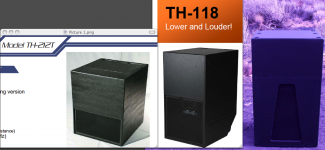I've been thinking of how to configure a tapped horn into a cabinet below a sealed box Synergy horn. I'd like the mouth to be horizontal at top, the width of the cabinet.
It occurs to me that a Paraline might be used here. Have the back of the driver in the mouth, its front facing down into the Paraline. The Paraline Expands and shapes the waterfront to the width of the cabinet. Further expansions snake downwards then up the back and out the mouth.
Any thoughts? Patrick, would this work? Tom?
It occurs to me that a Paraline might be used here. Have the back of the driver in the mouth, its front facing down into the Paraline. The Paraline Expands and shapes the waterfront to the width of the cabinet. Further expansions snake downwards then up the back and out the mouth.
Any thoughts? Patrick, would this work? Tom?
from what little i know of tapped horns, the cancellation dip is caused by the path length. In your idea i assume this path length would be increased, OR the rest of the expansion required would be shorter. If the length were greater, the dip would be lower, which i guess isnt a good thing. Another doubt i have is that usually the starting CSA is quite large, which again is a limiting factor to how high it could be used. Im no expert in TH design so i wouldnt write your ideas off, but like anything there are trade offs, and the potential problems i mention while worthy of consideration, arent prohibitive.
The Paraline is useful at high frequencies for narrowing dispersion, at lower frequencies it has no wave shaping ability.I've been thinking of how to configure a tapped horn into a cabinet below a sealed box Synergy horn. I'd like the mouth to be horizontal at top, the width of the cabinet.
It occurs to me that a Paraline might be used here.
A symmetrical fold, as used in the Paraline, reduces the ratio of path length to plywood used by 50%, not a useful feature when trying to maximize a sub's internal volume.
As long as the mouth area conforms to the TH design's expansion rate, the shape makes relatively little difference in the output.
Certain fold patterns, such as in my Keystone sub design, actually benefit from a thin exit shape.
Three examples of TH below are included, as you can see, the mouth shape is quite different in each, and an even more narrow exit could be used if needed for designing to a specific shape.
The Keystone design on the right hand side has nearly identical phase and frequency response to the very different looking DSL TH-118.
Art Welter
Attachments
- Status
- This old topic is closed. If you want to reopen this topic, contact a moderator using the "Report Post" button.
